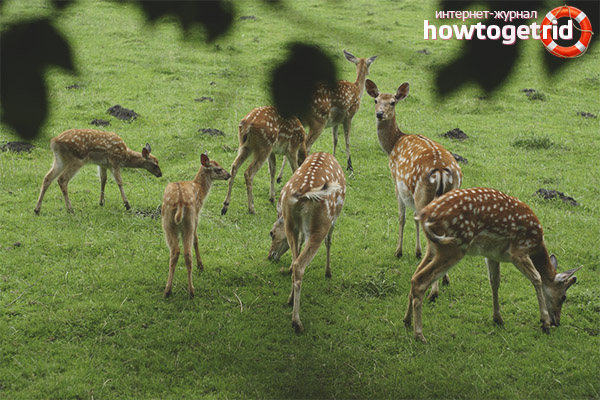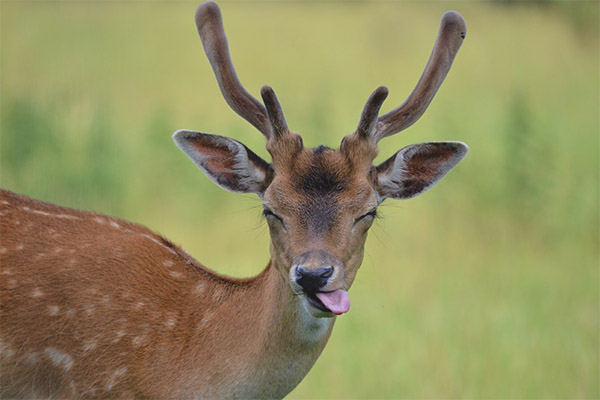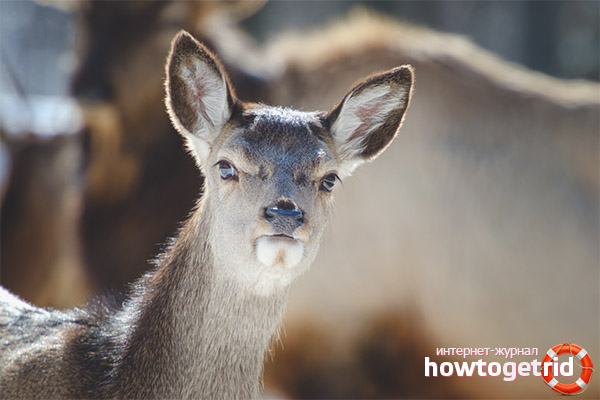The content of the article
You can find a lot of tales, legends and rumors for such an elegant animal as a fallow deer. Often the image of this beautiful deer is inextricably linked with female qualities: slim, graceful, slim. At the same time, there is in this image something mysterious, some tinge of demonic. But in reality, what is a doe? Affectionate and sensual, or dangerous and powerful?
Appearance
There are two species of fallow deer: European and Iranian. The first species is the most common, but it is considered that initially only Iranian fallow deer existed on the land. Dimensions of a deer that lives in Europe can reach 100 centimeters in height and 160 centimeters in length on average. The weight of an adult male reaches 105 kilograms, while females weigh about 65 kg. The animal has a not very long tail, on the head of a male there are weighty horns that take on a spade-like appearance at the time of maturation.
Along with other varieties of deer, the size of the horns of a male doe increases with its age. With the onset of April, the horns are dropped and over the next year they grow back from small horns. The color of the doe's body depends on the season. In winter, the neck and head of the animal has a brown tinge, the doe is completely black from the sides and back, and the bottom is predominantly gray.
But in the summer the doe becomes more attractive and beautiful: from the sides and back the hair becomes lighter, decorated with elegant white spots, and the limbs and abdomen become almost white.
Often you can meet a completely black animal (the so-called melanists) or a completely white doe (albino). From ancient times such animals were considered to be those who foreshadowed various incidents and events.
Externally, the Iranian doe does not differ in comparison with the European variety. We can only say that the males of this animal are slightly larger - the length of their body can reach a couple of meters. If you compare the doe with other varieties of deer, then it can be noted that it has a stronger and stronger muscle, the neck is more developed, and the legs are less long.
Habitat
Since ancient times, they were transported to Italy and Greece, a little later to the territory of Britain and Europe. Up to the sixteenth century, these deer lived in Poland, Latvia, in the west of Belarus. But at the present time there is hardly a chance to meet these animals.
Over time, the doe came to the north and south of America, to Japan and Chile, Madagascar and Australia. However, by now the doe has completely disappeared from many points on the world map.
At present, the Iranian fallow deer is listed in the Red Book - the number of the species is literally several hundred animals. Slightly better things are with the European hind, the number of heads reaches about a couple of hundreds of thousands. A fallow deer is an animal that predominantly lives in a wooded area, where there are many open fields, lawns and bushes. However, once in the unfamiliar conditions for themselves, this deer can quickly adapt to them.
Character and way of life

In the summer, the doe usually lives alone or organizes a few groups. Yearlings adhere to the mother, without departing from it for long distances. These animals are most active in the morning or in the evening when the air is cooler. It was at that time that fallow deer begin to graze and visit watering places.
When the hot hours come, these animals prefer to spend their holidays in spacious sun beds located in shady areas. Usually, the fallow deer finds such places in the thickets of bushes near various reservoirs. There they have the opportunity not only to escape from the heat, but also to avoid the accumulation of midges.
The fallow deer is no different with timidity and timidity. In comparison with other representatives of deer, doe are not so fearful and cautious. If these deer live in the park near the person, they can take food from human hands and become partly tame.
On the threshold of winter, deer usually organize large and numerous herds, male and female in which they move together. At this particular time, one can see the most spectacular and spectacular ritual inherent in deer - tournaments, bouts and further weddings.
Fighting for the attention of females, animals can break their rival neck, and in some cases - themselves. This fully indicates the severity of such battles. It also happens that both males die if their horns interlock tightly.
After the female and the male converge, and the doe begins to bear the offspring, its chosen one moves away and prefers to live alone. But with the onset of severe cold, the males again gather in a certain group in order to spend the winter hard season.
Fallow deer rarely leave favorite places. These animals prefer not to leave the borders of their territory. Their daily route is monotonous, runs through the same places. In addition, these deer do not have good adaptability to movement through the snow due to the small size of the limbs.
However, due to the wonderful sense of smell, the fallow deer can easily find food under the snow deposits for itself, to which moss and plant roots can be attributed. Also, this deer has a sharp ear, which compensates for not the strongest vision. Despite this, the animal will easily hear a person more than 300 meters away.And when doe is in danger, they can usually successfully escape. The length of the doe jump reaches a couple of meters. In addition, these animals swim great, but only enter the water when absolutely necessary.
Doe's food
Fallow deer refers to ruminants that are herbivores. Their diet includes plant food: tree bark, fragments of leaves, branches, bushes and grass.
These deer can eat a variety of seasonal plants. In the spring, their favorite delicacy is the shoots of mountain ash, pine or maple, snowdrops and anemone. In the summer, they gladly eat chestnuts, various berries and grains, sedges, mushrooms and acorns or chestnuts that have fallen from the trees. With the onset of cold weather, the diet consists of branches and bark. In addition, the doe is trying to find an area with soil that is rich in various salts. It is necessary to replenish mineral reserves.
Those people and organizations that have a certain interest in expanding the population of these animals in a particular locality usually form solonetse for them, create artificial feeders,that are filled with grains and hay. Also, sometimes whole fields are planted on which plants grow in the doe’s diet.
Doe's life and breeding
By about September, these animals begin the stage of the rut, which continues until the very end of autumn. The females prefer to keep away from the fights between the males, which, in turn, suffer extremely in these months not only from severe injuries, but also from lack of food.
They significantly lose weight, since all the energy of the male is directed only to have time to cover the maximum number of females. They are made to shout loudly, telling all the surrounding animals about their own right to own a particular territory and the females that live there.
The male becomes more agile, aggressive and extremely excited. In addition, their usual fearfulness and caution are lost. When several powerful and adult males come to the herd of females, they immediately drive away more timid teens from there. The yearlings, in turn, during the rut live in some distance in order to return to their mothers by winter.During the season, the male covers on average about 8 females.
The female bears offspring for about eight months, and by May, one cub is usually born. For the next 4 months, he eats maternal milk for food, eventually switching to the food inherent in the adult. By the age of two or three, the young deer reaches maturity. On average, the fallow deer lives about 28 years.
Video: Doe (Dama dama)












To send